In anticipation of the St. Patrick’s Day holiday, we wondered how many green specimens we could find in our Natural History collections. In addition to the ones we thought of immediately (like a Luna Moth!), we also found a couple that might be unexpected or unusual. We chose five of these green specimens to showcase and their stories.
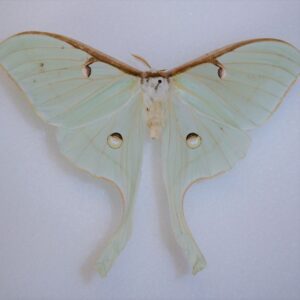
N 15401 – Luna Moth, Actias luna. Collected by W. G. Owen on July 20, 1970 in Highland County, Ohio.
This well-known and distinctive mint-green member of the giant silkworm moth family is common throughout Ohio, but rarely seen as they’re primarily active at night. Like all members of this moth family (Saturniidae), the adults live for only about a week. This species has one to two generations a year in Ohio, with the second brood developing in late summer to early fall and wintering over to emerge in June of the following year. Males have large “feather shaped” antennae, while the female’s are much smaller. The caterpillars feed on leaves of sweet gum, hickory, walnut, pecan, birch, and persimmon trees, as well as sumacs. They make their cocoons in leaf litter. You can increase your chances of seeing these and other colorful and beneficial insects in your yard by leaving your leaves in the fall!
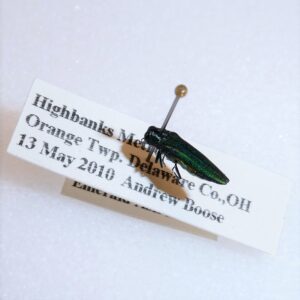
N 42714 – Emerald Ash Borer, Agrilus planipennis. Collected by Andrew Boose on May 13, 2010 at Highbanks Metropark, Delaware County, Ohio.
Although beautiful, the tiny and aptly-named Emerald Ash Borer is a harmful invasive species.
The story of the Emerald Ash Borer (EAB) began in 2002 when it was first recorded in Canton, Michigan, most likely accidentally introduced via the wood of shipping crates from its native Asia. The EAB lacks predators in North America to keep it in check, and quickly spread from there, decimating our native ash trees as it spread. The EAB larvae harm ash trees by burrowing under the bark, leaving distinctive tunnels behind. After a few years the host tree is no longer able to transport adequate nutrients and water to its canopy, and dies. Adult EABs also feed on foliage, but do not do enough damage to harm the tree.
This specimen documents a continuing effort to monitor the status of this highly invasive species in Ohio. You can help stop the spread of this and other harmful species such as Spotted Lanternfly and Asian Longhorned Beetle by not moving firewood – remember to buy and burn local wood only! Visit DontMoveFirewood.org to learn more about how you can help keep invasive insect and fungus species from spreading.
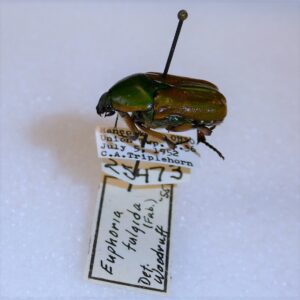
N 25473 – Emerald Euphoria, Euphoria fulgida. Collected by Charles A. Triplehorn on July 5, 1952 in Hancock County, Ohio.
This rarely seen iridescent green beetle in the scarab family (Scarabidae) can be confused with the larger Green June Beetle (Cotinis nitida) which is commonly found in urban areas of Ohio buzzing low to the ground over lawns on early summer evenings. However, the Emerald Euphoria is half its size (17mm) can be found in fields and meadows feeding on flower pollen.
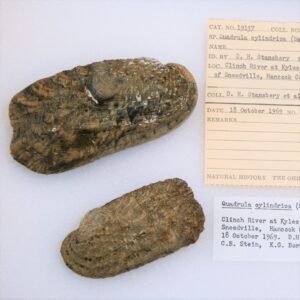
N 19137 – Rabbitsfoot mussel, Theliderma cylindrica. Collected by David H. Stansbery, Carol B. Stein, Kathy G. Borror, and Jon E. Ditmars on October 18, 1969 in Hancock County, Tennessee.
These beautiful shells with tan and dark green markings belonged to Rabbitsfoot, a freshwater mussel species native to Ohio as well as Tennessee where these specimens were collected.
Historically widespread throughout the Ohio and Mississippi river watersheds, this species has disappeared from half of its historic range. It is listed as Critically Imperiled, Imperiled, or Extirpated in half of the states in which it now occurs, and the other half have not been adequately surveyed.
Ohio once boasted one of the highest freshwater mussel diversities in the United States, with 127 of North America’s 297 freshwater species documented as of 1900. Due to the continuing degradation of Ohio’s waterways from industry and large-scale agriculture, 57 of those 127 species are now extinct or endangered.
Freshwater mussels are nature’s filters and are indicators of high water quality and health, as they are very sensitive to pollution. Individual mussels can live up to 100 years and are an important food source for wildlife as well as people.
Freshwater mussels are obligate parasites during the larval part of their life cycle, and must develop on fish gills. Many mussels have eye spots and other markings on their muscular feet, which they wave in the current to attract their hosts. When a fish approaches to eat the presumed tasty morsel, the mussel ejects its larvae at the fish’s face and they attach to the fish gills. This process does not harm the fish. A few weeks later, the larvae drop off in a suitable place after being transported upstream by their host to finish their development and live out their lives. Similar to caterpillars, each species of mussel can only reproduce using specific host species of fish. If their host fishes are not available, they will be unable to reproduce and die off. Both the loss of their host fish and poor water quality have contributed to the loss of Ohio’s freshwater mussels.
A great summary of the fascinating mussel life cycle is here:
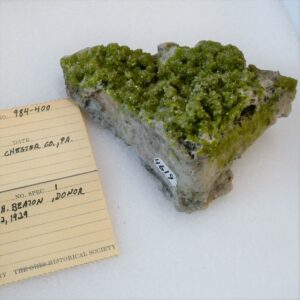
N 4619 – Pyromorphite. Donated by Ralph H. Beaton May 12, 1929, collected from Phoenixville, Chester County, Pennsylvania.
Pyromorphite (Pb5(PO4)3Cl) can come in a variety of colors from orange, yellow, brown, white, or colorless as well as the apple green hue seen in this specimen. It is found in the oxidized zones of lead deposits and is a lead chloride phosphate mineral. It is so similar to mimetite and vanadinate, other apatite phosphate minerals in this series, that they can only be distinguished by chemical testing. Crystals are hexagonal and barrel-shaped. It is 3.5 – 4 on the Mohs hardness scale (about the same as a copper penny) and fluoresces yellow under long wave ultraviolet light.
We hope you enjoyed exploring a few of our green specimens with us. Have you visited the Ohio History Center lately? I wonder how many green Natural History specimens and History objects you can find on display?